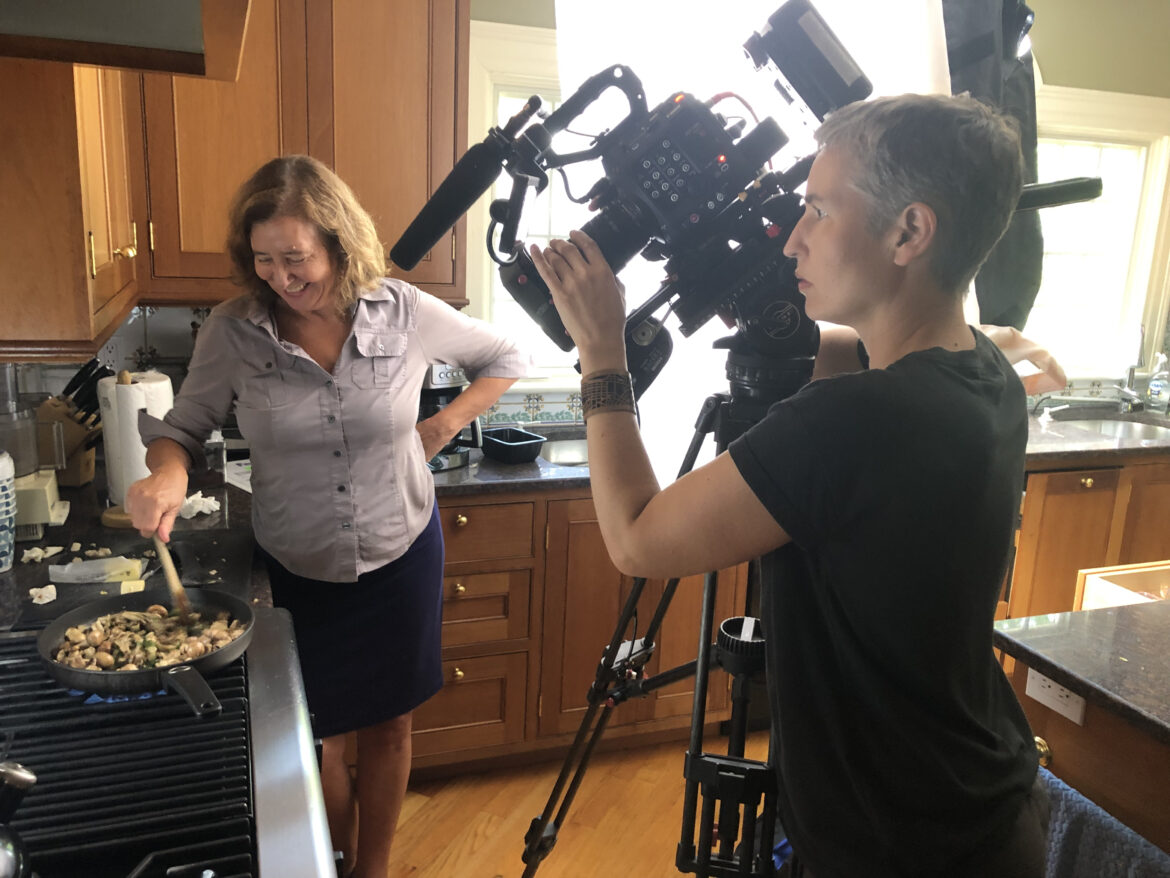In this part of the interview with Elisa New, creator, director, writer, and host of Poetry in America, a PBS series in its fourth season, we look at two episodes that include New Hampshire-related guests. Below is Part 1 of the interview.
In Season 2’s, Finishing the Hat by Stephen Sondheim titled after “perhaps Stephen Sondheim’s most autobiographical song, from Sunday in the Park with George—Finishing the Hat”, Nashua native Kerry O’Malley, whose acting credits include, Gray’s Anatomy, Boardwalk Empire, and The Happening with Mark Wahlberg. Kerry, straight up, a very accomplished Broadway performer, weighs in on Sondheim’s amazing style and writing of the song.
In Season 4, two poems are discussed. “Mushrooms, Weakness and Doubt,” delves into a poem by Sylvia Plath, “Mushrooms,” and the Kay Ryan poem, “Weakness and Doubt.” Serita Frey, Professor of Environmental Science at the University of New Hampshire helps us to understand the nature of mushrooms, and fungi, and how they impact us and has discussed in a scientific paper and has said, “To me, it’s just always fascinating that the activities of something that’s microscopic, that we can’t see and that few people think much about, can actually scale up and have implications for the whole planet.” We come to know mushrooms on a closer, malevolent level through Plath’s and Ryan’s poetry. Perhaps, it takes a poet to see the things, to interpret for us, those deeds, and actions we cannot see or refuse to see.
FINISHING THE HAT
My first question to Elisa was how is a lyric, songwriting, poetry?
“It’s certainly a matter of debate. Sondheim himself made the distinction between poetry and lyrics. His goal was to fit lyrics to the dramatic purposes of the musical plays that he wrote. He’d say, lyrics have to be clear, they have to tell a story. That’s not something we would say of all poetry. I include song lyrics in Poetry in America not to insist they are exactly the same, but, certainly in the case of Sondheim and other artists to show where poetry for the page and lyrics for the voice or the stage can really overlap and share many of the same goals. What’s fantastic about “Finishing the Hat” is that it is about the process of making art, about the way imagination works across art forms. “Finishing the Hat” is not about writing. It’s about painting. Implicitly, it’s about Sondheim being a playwright and a songmaker. It’s about art itself. There is a famous form called ekphrastic poetry which is a term for poems about paintings. While I would not use every song lyric, Sondheim’s song lyrics go so deeply. In a way, every poem is in some way about the kind of mystery and the magic of how we can conjure experience, printed on a page. It’s very mysterious.”
In the episode, “Finishing the Hat, Elisa draws on Broadway stars to discuss Sondheim’s lyrics and how they join with the music. Nashua, New Hampshire’s Kerry O’Malley is joined with Raul Esparza and Donna Lynne Champlin, among others. The character, George, is a fictionalized version of Georges Seurat who was a famous French painter who specialized in pointillism, the technique of making small strokes or dots on the canvas and when looked at from a distance create a picture. George in the musical is obsessed with finishing the hat in his painting that a woman is wearing. George’s painting borrows from Seurat’s famous painting A Sunday Afternoon on the Island of La Grande Jatte.
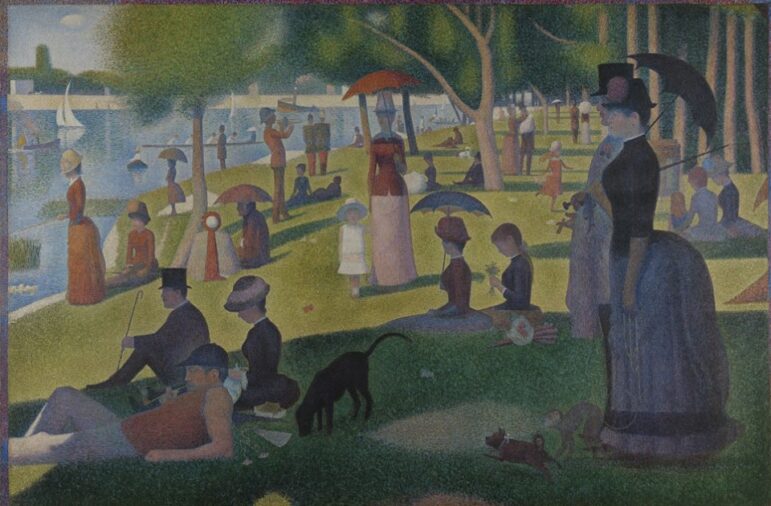
Georges Seurat’s A Sunday Afternoon on the Island of La Grande Jatte. (In the picture above, the woman at the right is the hat Seuret frets over.)
“Seurat famously struggled over the hat. The musical tells the story of how Seurat is so involved in his art, he loses interest in the woman he loves. The musical is also about the sacrifice artists make and the way in which they fall in love with the act of creation, and isolates them and how necessary it is. There are ironies all over this work. In this song where there is nothing that the artist is so focused on as the woman in the hat, but the woman herself kind of dissolves.”
Sondheim’s George sits in his small apartment looking out a window, something so thin and breakable, a pane of glass, he peers out to the town observing the hustle and life that is going on just outside. George is supposed to meet the woman of his affections and he leaves her hanging. He does not leave his work. He must finish the hat.
“A window is such a poetic image,” New says, “A window, yes, it’s an obstacle but it’s also a lens. It looks back at you. And it sees you’re seeing through it and that’s the art. The very thing that he uses to get closer to his world also blocks him from that world and that is a theme for artists since the beginning of time.”
Sondheim’s George gives us a man who blames the woman for leaving.
How the kind of woman willing to wait’s
Not the kind that you want find waiting
To return you to the night,
Dizzy from the height,
And when the woman that you wanted goes,
You can say to yourself, ‘Well I give what I give.’
But the women who won’t wait for you knows
That, however you live,
There’s a part of you always standing by,
Mapping out the sky,
Finishing a hat…
-Stephen Sondheim’s lyrics Finishing the Hat
In Elisa’s conversation with Kerry O’Malley, Kerry remarks on the use of ‘ing’ ending words throughout the song such as finishing, planning, nothing, willing, studying, and starting.
“Kerry is an example of someone, and so many performing artists are like this, she was so perceptive. Her reflections on consonant sounds, on how Sondheim was crafting the language, thinking about the voice, how vowels are open and allow you to open up and sing. That was so brilliant. It’s an example of how bringing experts from other fields and just people who know different things enriches an interpretation.”
MUSHROOMS, WEAKNESS AND DOUBT
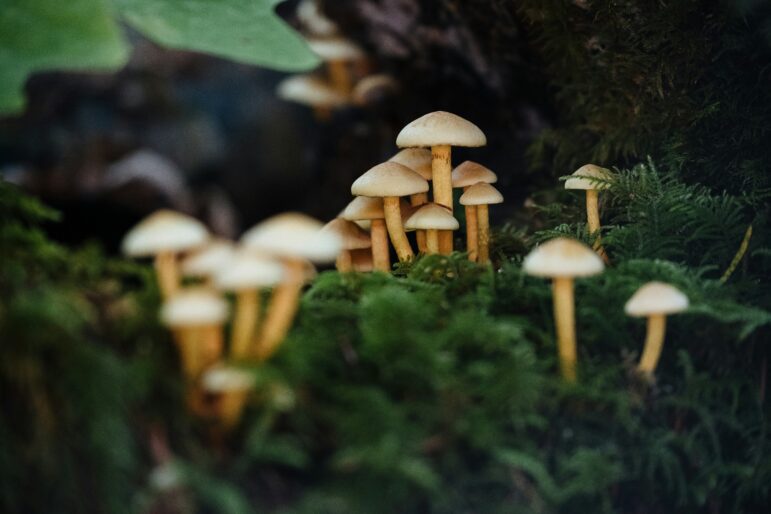
Photo by Jesse Bauer on Unsplash
The Poetry in America episode, “Mushrooms, Weakness and Doubt,” goes dark in the same way that mushrooms need subdued, or low light to grow. The fear of mushrooms, mysophobia, is prevalent enough to have its own phobia. On the other hand, mycophile refers to those who like and appreciate mushrooms. “Mushrooms are invaders,” was said and another spoke about the “primal fear of our own mortality.”
American poet and novelist, Sylvia Plath, was walking in the woods one day when she sees a mushroom. She then writes this fabulous poem that has so much deep meaning. New explains the poem for us.
“I should say that when I decided to do a Sylvia Plath episode, I quite deliberately didn’t do an episode that was the usual story that we rehearse about Sylvia Plath which is how unhappy she was, how she committed suicide, how angry she was at her father. She has come to represent female discontent. I always admired her as a poet. Female disempowerment is also in this poem, but that’s not by any means the only thing there is to say about it. I very much enjoyed doing an episode that just allowed us to pay attention to Sylvia Plath as such a meticulous craftsperson. I loved the one interpreter said how the poems, the shape of them on the page, they look like little buttons. The fact that the stanzas they look like little fungi.”
“Plath was such an extraordinary manipulator of tone. Somehow she writes these poems so that she’s telling us how to voice them and they sound a little creepy. I was really interested in all of the formal decisions she made and how effective they are in the ways in which one of the interpreters brought out drawing on fairy tales and the mythology of mushrooms. She was a very attentive observer of them as real things with real characteristics. You can’t see it one day and it’s above the ground the next.”
Overnight, very
Whitely, discreetly,
Very quietly
Our toes, our noses
Take hold on the loam,
Acquire the air.
-Sylvia Plath’s poem, “Mushrooms”
We next talk about the other poem, Kay Ryan’s poem, “Weakness and Doubt,” and the way we love construction, they love hollowing.
“It is so interesting because scientifically you can see how researched it is down to all the language she uses, rusts and dusts and powdery. She really knows her mushrooms and the argument she’s making for how human beings like construction and mushrooms like breaking things down.”
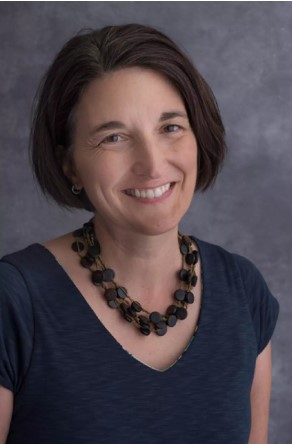
Serita Frey, UNH Photo
New had previously talked to Serita Frey, American academic and ecologist and Professor of Environmental Science at the University of New Hampshire, about the poem and credits her for inspiring an entire episode on mushrooms.
“This episode began not as television, it began as educational content for a course called “The Poetry of Earth, Sea, and Sky, that I made a number of years ago. I thought Sarita was so fantastic at what she did on mushrooms, let’s build a whole episode around that. A New Hampshire person led the way there.”
…rusts, grey talcums,
the whole palette
of dusts and powders
of the rot kingdom
and do not share
our kind’s disgust
at dissolution,
-Kay Ryan’s poem, “Weakness and Doubt”
Andrew Weil says in the episode, “I think she sees them as invaders. They appear very soft and nonaggressive but know, they’re coming. There actually was an old sci-fi movie, “The Invasion of the Mushroom People.” He adds that you, “need that balance of growth and decay for life to succeed.”
Serita Frey comments in the episode, “Weakness and doubt is what fungi exploit in their dissolution of material. This is their sort of robust kind of business. To me, this is the absolute essence of the poem. She sets up this juxtaposition between the ‘we’ which is humanity, society, where we are always constructing things, where the fungi are always dissolving, decomposing, hollowing things out.”
The last lines in Plath’s poem are:
We shall by morning
Inherit the earth.
Our foot’s in the door.
At the end of our conversation, I express that New is bringing poetry to people in a way that they’re unsuspecting. I had been won over with just one episode.
“Thank you. That is what we try to do. It’s interesting, people who watch one tend to watch more. We all have so many choices these days. I’m very fortunate that I have the team I have and that we get enough money to make it.”
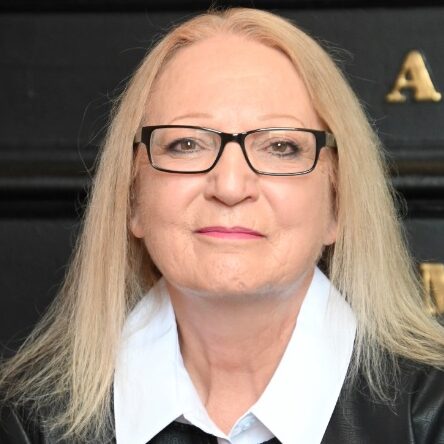
Beverly Stoddart is a writer, author, and speaker. After 42 years of working at newspapers, she retired to write books. She is on the Board of Trustees of the New Hampshire Writers’ Project and serves on the board of the New Hampshire Center for Public Interest Journalism. She is the author of Stories from the Rolodex, mini-memoirs of journalists from the 1960s, 1970s, and 1980s.
